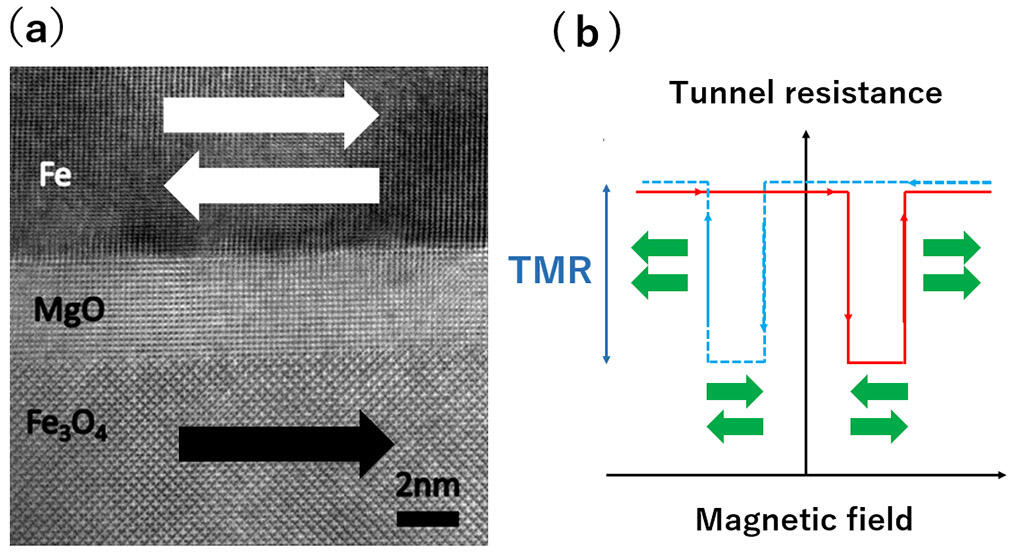A research group consisting of Akima Yasui, Graduate Student, Graduate School of Chemistry, Hokkaido University; Taro Nagahama, Associate Professor, Graduate School of Engineering, Hokkaido University; Toshihiro Shimada, Professor, and Jun Okabayashi, Associate Professor, Graduate School of Physics, The University of Tokyo; and Shuta Honda, Associate Professor, Faculty of Systems Science and Engineering, Kansai University succeeded in realizing a highly negative tunnel magnetoresistance (TMR) effect using iron oxides. The TMR effect is an important phenomenon that serves as the basis of the field of spintronics and is utilized in many electronic devices. Most devices use metal magnetic materials to achieve this effect. Recently, research with the aim of using oxide magnetic materials to achieve the same effect has been conducted.
Associate Professor Nagahama made the following remarks regarding Fe3O4, a typical iron oxide. "This material has been theoretically predicted to present a large negative spin polarizability with high potential as a spintronics material. Although spectroscopic studies have experimentally confirmed its high-spin polarizability, there exist no reports of large TMR effects, which are crucial for device applications." One of the most important material parameters for a spintronics material is its spin polarizability. Electronic-state computations predicted that Fe3O4 presents a substantially large negative spin polarity of -100%.
The research group applied a reactive molecular epitaxy (crystal formation) method in which iron oxide thin films were prepared via vapor deposition of iron in an oxygen atmosphere. Single-crystal thin films of Fe3O4 were prepared by precisely controlling the oxygen pressure, and the possibility of effectively realizing the high-spin polarizability of the material was examined. They achieved a negative TMR effect of -55.8% at 80 K (-193 °C). This value is equivalent to -126% for electronic elements exhibiting a positive TMR effect. Thus far, there have been no reports indicating such high values using iron oxides; this is the first time the high-spin polarity of Fe3O4 has been demonstrated via the TMR effect. Furthermore, the research group found that the temperature dependence of the TMR effect significantly varied according to the oxygen pressures used during fabrication.
Associate Professor Nagahama says, "In terms of basic physical properties, our next task is to obtain an in-depth understanding of the mechanisms by which large TMR effects can or cannot be obtained, as well as the difference in electrical conduction between TMR elements in metal systems. In terms of applications, we intend to expand our findings to the development of devices that leverage materials with large negative spin polarizability."

(a)The cross-sectional Transmission Electron Microscope image of an MTJ. Arrows indicate the direction of magnetization for each layer.
(b)A plot of the TMR effect with Fe3O4 electrode. Magnetizations alter the magnetic configurations from parallel to antiparallel by an external magnetic field (horizontal axis), which leads to changes in tunnel resistance (vertical axis). It is upside down compared to a typical (positive) TMR curve.
Credit:Hokkaido University
The TMR magnitude can be obtained by dividing the magnitude of the change in resistance by the original resistance value. One method uses the maximum resistance value as the original resistance value, whereas the other considers the minimum resistance value as the original value. In the former, the maximum possible TMR value is 100%, whereas in the latter, it is infinity. Elements with a negative TMR, such as the one discussed here, exhibit opposite magnetic states and maximum/minimum resistance values in comparison with conventional elements with a positive TMR. Typically, there exist equal numbers of electrons with both spins. However, in magnetic materials, one spin is more prevalent than the other. In particular, imbalance in spin numbers at a special energy level called the Fermi level is referred to as spin polarizability.
This article has been translated by JST with permission from The Science News Ltd.(https://sci-news.co.jp/). Unauthorized reproduction of the article and photographs is prohibited.




